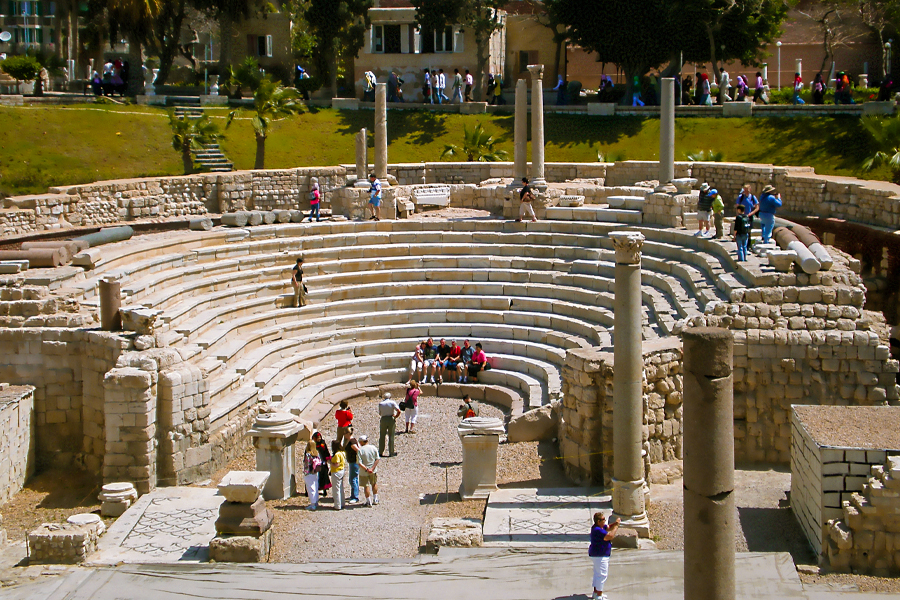In 332 BC, Alexander the Great built the city of Alexandria on the site of an old fishing village. It was successful for almost 500 years and was Egypt’s capital during essential times. Greek thinkers and philosophers went to Alexandria to learn more about Egyptian culture, which was highly regarded all over the world at the time.
Under Ptolemaic rule, several buildings that are now considered historical landmarks were built, as well as several roads that connected the city to the ports and islands in the area.
Many of Alexandria’s most famous buildings were built by the Ptolemaic dynasty and the Roman emperors. These buildings include the lighthouse, Pompey’s Column, the Library of Alexandria, and many more. Also, the Roman Amphitheater of Alexandria is one of the city’s most famous buildings. In the following few paragraphs, you’ll learn more about its history and the architecture used to build it.
In Alexandria, there is a Roman amphitheater.
The word “amphitheater” comes from an old Greek word for an open space used for many different events. n Greece, amphitheaters were either round or oval, and there were several steps for people to sit on. hen the Romans were in charge of all these countries, including Italy, Turkey, Jordan, and Greece, the arena was more or less like an open-air stadium. t was sent to all of those countries. rchaeologists found the Alexandria Amphitheater by accident in the year 1960. hen the Egyptian government was getting ready to build a building in the Kom El Dekka, one of the workers who was getting the site ready found a solid pillar buried in the dirt and sand.
he engineers came up with this idea. lmost immediately, a group of excavators went to the site to check how their work had turned out. n the 20th century, when the Roman theatre was found, it was seen as a significant archaeological achievement. t has been shown that work on the theatre started in the fourth century AD and continued until the seventh century.
his means that it was not built during the times when the Romans, Byzantines, or Muslims were in charge. r Company knows how vital these historic sites are because so many of our customers want to see the .
We have included many Greco-Roman attractions in our Egypt tour . If you’re going to see more Roman attractions, you can find them all on the list of Alexandria day tour . If you’re going to see more Greco-Roman sites, just look at the list of Cairo day tours.
The plans for building the Roman theatre in Alexandria
A great example of a Roman theatre is the one that still stands in Alexandria. It has an auditorium made of marble, columns made of granite, five bays, and massive walls made of limestone as its base. In the past, the theatre was used for significant events and ceremonies and could hold up to 600 people. The part for the people watching was made of 13 rows of white marble, and the columns that held it up were made of granite from the city of Aswan, which is in southern Egypt.
The five compartments at the very top of the audience section were probably used to house royalty or other significant public figures during performances. Granite columns held up the vaulted ceilings of these rooms to protect the audience from the sun and rain. Most of these buildings were destroyed by an earthquake in Alexandria around the sixth century AD.
There are Roman buildings in Egypt.
In 31 B.C., the Romans took over Egypt. A a result, most important Egyptian sites were turned into busy commercial towns. E ypt’s archaeologists have found evidence of more than 700 villages, forts, gold mines, and roads built by the Romans in that country. T e Romans found Egypt to be an exciting place to visit, and the culture and customs of Egypt had a significant impact on them.
T e fact that they were buried in tombs that looked like those of the pharaohs and decorated their cemeteries with pictures of Egyptian gods shows how much the Egyptians’ religion affected them. E ypt has had many emperors since Queen Cleopatra, the last pharaoh of Greek descent, and Mark Antony committed suicide.
A ong with the Greek monuments that the Ptolemaic family built earlier in the country’s history, these emperors have left their mark on the land. T e Greek settlements of Philae and Dendera are, along with the Roman settlement in Egypt, some of the most impressive examples of Greek architecture in Egypt. W th the help of our operations staff, you can tailor your experience to your needs.


0 Comment